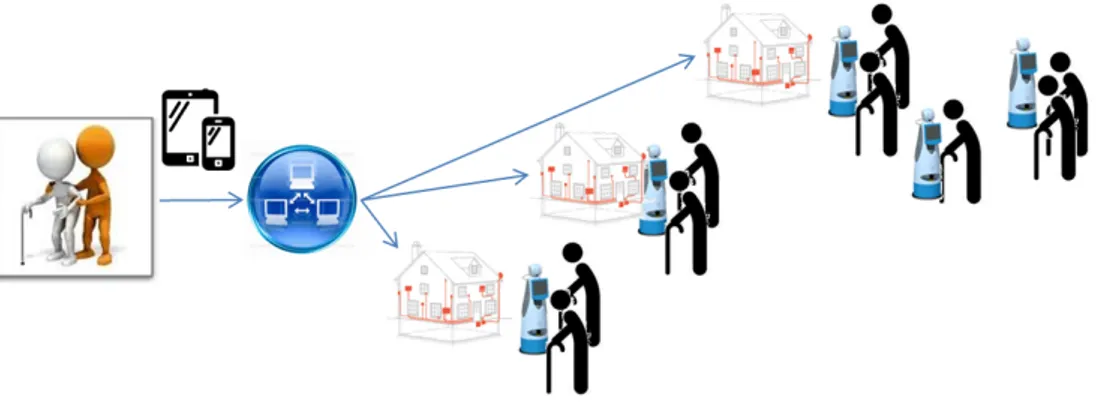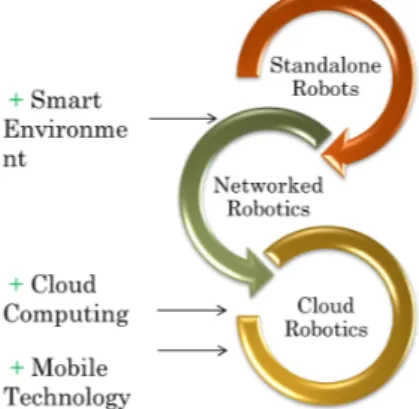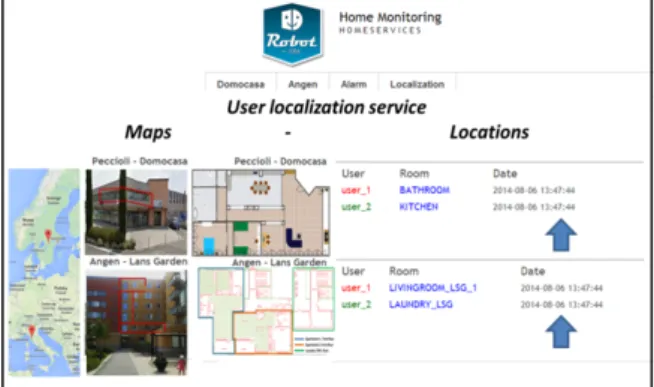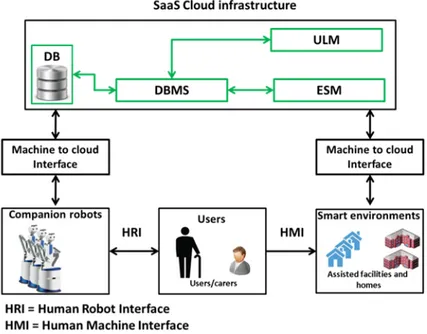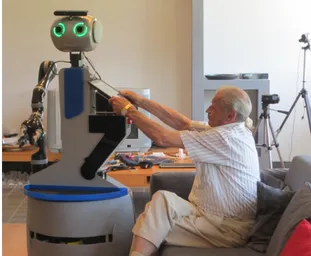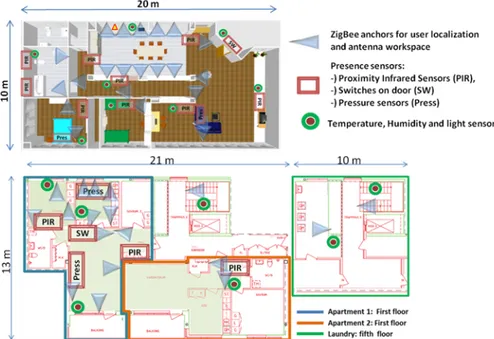Design of Cloud Robotic Services for Senior
Citizens to Improve Independent Living in
Multiple Environments
Manuele Bonaccorsi
a,c,∗Laura Fiorini
a,cSubash Sathyakeerthy
bAlessandro Saffiotti
bFilippo Cavallo
aand Paolo Dario
aaThe BioRobotics Institute, Scuola Superiore Sant’Anna, Viale R. Piaggio 34, 56025 Pontedera, IT E-mail: {m.bonaccorsi,l.fiorini,f.cavallo,p.dario}@sssup.it
bCenter for Applied Autonomous Sensor Systems (AASS), Orebro University, SE E-mail: {[email protected] ,[email protected]}
cEqual contribution to the work
Abstract. The paper proposed a cloud robotic solution for the healthcare management of senior citizens, to demonstrate the opportunity to remotely provide continuous assistive robotic services to a number of seniors regardless to their position in the monitored environment. In particular, a medication reminding, a remote home monitoring and an user indoor localization service were outsourced in the cloud and provided to the robots, users and caregivers on request. The proposed system was composed of a number of robotic agents distributed over two smart environments: a flat at the Domocasa Lab (Peccioli, IT) and a condominium at the Angen site of the Orebro science park (Orebro, SE). The cloud acquired data from remote smart environments and enabled the local robots to provide advanced assistive services to a number of users. The proposed smart environments were able to collect raw data for the environmental monitoring and the localization of the users by means of wireless sensors, and provide such data to the cloud. On the cloud, specific algorithms improved the local robots, by providing event scheduling to accomplish assistive services and situation awareness on the users position and environments’ status. The indoor user localization service, was provided by means of commercial and ad-hoc sensors distributed over the environments and a sensor fusion algorithm on the cloud. The entire cloud solution was evaluated in terms of Quality of Service (QoS) to estimate the effectiveness of the architecture.
Keywords: Aging well, cloud robotics, intelligent systems, indoor localization
1. Introduction
EU population ageing is a long-term trend that will almost triple the share of those aged 80 years or above between 2011 and 2060. This will increase the demand for Nurse Practitioners (+94% in 2025) [1] and Physi-cian Assistants (+72% in 2025) [2] with several im-plications for quality of care and for the configura-tion of future cost-effectiveness care delivery systems. One of the greater challenge in the next years will be
*Corresponding author. E-mail: [email protected].(phone:
+39 0587 672152; fax: +39 050 883101)
to fit to the reduction of funds for social-medical ser-vices, with the opportunity to provide socially sustain-able home care services to senior citizens. The num-ber of single elderly persons and single-person house-holds is increasing and one-in-six of all 74 million el-derly people now living in EU are at risk of poverty [3], in particular in the EU countries more suffering from the economic crisis such as Bulgaria (61,1%), Romania (35,3%), Greek (29,3%), Portugal (24,5%), Italy (24,2%) and Spain (22,3%) [4]. In this contex, the decreasing of worker population and the reduction of funds for social-medical services, due to the current economic crisis, couldn’t fulfill the demand for care.
society
The primary needs of seniors are to maintain as long as possible an adequate QoL, to be active and to par-ticipate in community life and to retain control over their own life even when they need care and assistance [5]. However, ageing causes a physiological decrease of motor, sensory and cognitive abilities of the people as well as a number of related frailties and physical impairments that reduce their independence. The re-duced mobility made it hard for seniors to join friends, familiars or participate to social activities out of their home. Physical impairments may limit the dexterity and force, creating the needs for support in object ma-nipulation and transportation. Furthermore, the people who suffer of cognitive impairments have trouble in re-membering appointments and commitments, learning new things, concentrating or making decisions about everyday life. Generally according to that state of the art, the well-being and the QoL of seniors are strictly related with the ability to:
– Manage properly multiple and chronic diseases at home- Most of older when affected by one or several chronic diseases may require the fre-quent taking of different drugs, the performance of specific therapies, the periodic monitoring of health parameters and the adoption of a specific and healthy life style. These care procedures are often complex and can induce mental confusion in senior patients, and the consequences of im-proper medications can be serious. Indeed it was estimated that preventable errors contribute to 33-69% of hospital admissions [6]. Besides better managing the effect of polypharmacy on older persons, these need to be supported and helped to monitor their treatment [3].
– Get access to services and limit isolation and the sense of loneliness- Most of European citizens lives in urban areas [7] and services are concen-trated on there, to the detriment of persons liv-ing in rural areas. For this reason senior people living in rural area are highly at risk of isolation. In these situations, older persons rely on the help
which need to be addressed [4].
– Be socially active- Because of the extension of life expectancy [8], older persons live many years after their retirement in which they are healthy and potentially active. Most of them lives as a couple or alone [9]. With the decreasing of tra-ditional social networks (family members geo-graphically far, friends and older family members died, etc.), senior people tend to have less possi-bilities of social contacts and active participation to the community life, thus the active ageing is an important opportunity for the society [6]. Informal caregivers sometimes assist and monitor their old-aged relatives continuously [3], with several implications on their personal and professional life, the quality of the assistance and the responsiveness and ef-fectiveness in case of critical situations. Also profes-sional care providers are facing new challenges in the today world, in providing traditional home/long-term cares, senior housing or day/night cares, to a broader number of people. All these services require the mas-sive involvement of professional caregivers that are ex-pected to be insufficient in number [7] and inefficient for the growing number of elderly citizens. In this con-text ICT and robotics services can empower profes-sional carers and family by supporting them in care process (see Fig. 1).
3. Aims of the paper
In this context, the aim of this paper is to present cloud robotic services for senior citizens to improve independent living in multiple environments starting from an analysis of previous works.The proposed sys-tem distributes the computing work-load over sensor networks, robots and a cloud platform to perform the required services. Thanks to the use of cloud resources, part of the system algorithms can be stored there and can be provided in a Software as a Service (SaaS) modality. Additionally, the paper investigates the ad-vantages provided by an user localization service on the cloud, devotes to improve assistive robots in a mul-tiple users and mulmul-tiple stakeholders scenario.
Fig. 1. Modern ICT and service robotics can improve the professional life of carers by supporting them in the remote and continuous assistance (either physical and cognitive) of seniors.
Moreover, the proposed system aims to provide a paradigm of care where one caregiver is able to man-age more seniors at the same time, regardless to the time, the location of the users and the number of services to be addressed simultaneously. Particularly it suits for nurseries, assisted residential buildings or whatever caregivers assist senior citizens continuously. The system is intended to provide a personalized med-ical support to the users in a continuous manner and with high quality, by leveraging the use of compan-ion robots, distributed sensors in the environment and a cloud platform. In such situations, assistive robots provide advanced services with a high reliability and service availability, to improve the QoL of caregivers, alleviating the amount of stress and workload.
The paper is organized as follows. In the first part, the authors present the trend over the use of robotic solutions in Ambient Assisted Living (AAL) applica-tions, passing from the stand-alone robot paradigm to the cloud robotics paradigm. In the second part of the paper, the authors proposed and describe their cloud robotic system which include the hardware part (sen-sor networks and companion robot) and the software part. Additionally, they describe two application sce-narios. In the third part, the paper present the imple-mentation and the experiimple-mentation of the system. It has been tested into two different experimental sites (one in Italy and one in Sweden) to assess the feasibility and the QoS.
4. Robots in Aging Society
The society will require new technologies and ser-vices in order to make population ageing socially sus-tainable guaranteeing adequate well-being. For these
reasons ICT systems and robotics services have been developed to provide valid solutions to support the in-dependence of elderly people and promote sustainable healthcare systems.
Analyzing the current state of the art, it is possible to recognize a trend over the use of robotic solutions (see Fig. 2). Earlier solutions for elderly assistance were based on the use of stand-alone assistive robots or sen-sor networks dedicated to accomplish specific tasks, like home cleaning, walk support or escorting, improve personal communications, perform activity monitor, provide safety and security services [10].
Recently, standalone robots have been integrated in smart environments to act as simple companion robot [11] [12] or to provide complex assistive services [13] [14]. In this new paradigm, called networked robotics [15], robots provides a number dedicated services to the users anywhere in the workspace and anytime, by leveraging the use of wireless communications and the cooperation between robotic agents. In this way smart environments and intelligent agents extend the effec-tive sensing range of robots improving their planning and cooperation capability. Nevertheless networked robots have limited computing capabilities since they rely on the hardware installed on the robots and on the distributed agents, and it could not be sufficient for continuously support seniors and carers in daily activ-ities. Some of these constraints can be overcome inte-grating robot with cloud computing resources through the concept of cloud robotics [16]. This concept leads to more intelligent, efficient and cheaper generation of robotic networks. The big opportunity to develop and improve this idea is now [17] because of the rapid and exponentially growing of wireless communica-tions both outside (3G, LTE) and inside home
(Wi-sent the brain of the robot which can support elderly persons providing innovative assistive services. Cloud robotics for the delivery of healthcare services would enable traditional health care systems to assist and sup-port continuously the ageing population from home to hospital or from residential facilities to aggregative centers.
The cloud resources would allow to development a new generation of socially believable robots able to mimic human behavior or interact with people safely and comfortably. It is evident how the power of cloud robotic paradigm is strictly correlated with the po-tentiality of the advanced artificial intelligent algo-rithms distributed on the cloud resources. Cloud re-sources could be used to increase the complexity of the robot behaviors without sacrifice its responsive-ness. For instance, socially believable navigation algo-rithm, human behavior recognition and context aware-ness would be performed fluently in the cloud improv-ing the robot’s acceptability. Assistive robots and smart agents on the ground, in private home, nurseries and aggregative centers would be able to collect a huge amount of information on the seniors’ health status and activities. The assistive robotics would thus enter in smart city contexts, by monitoring social trends and behaviors by means of artificial intelligent stored in the cloud. For example, big data analysis would allow to monitor the spreading of illness (e.g. flue and age re-lated diseases) to improve the situation awareness of professional carers and public institutions.
5. The role of artificial and distributed intelligence Stand-alone robots have a limited sensing range and their monitoring capability is locally constrained in the neighborhood of their position. The continuity of care have to be demanded to distributed physical agents in the environment and software algorithms, to perform users and environmental monitoring to a greater extent. According to the current state of the art, smart envi-ronments were typically conceived to monitor the ac-tivity of a restricted number of people and provide per-sonal communications, energy saving, safety and
se-Fig. 2. Trend of development of robotic solution in unstructured en-vironments starting from stand-alone solutions toward a cloud social robotics.
curity services. Mileo in 2008 [19] described a smart home, that consisted of environmental and wearable sensors and a reasoning algorithms for critical situa-tion recognisitua-tion, posture analysis and user localizasitua-tion. The Casattenta project described by Farella et.al [20] introduced a comprehensive ambient Intelligence for AAL that used wireless sensor networks to improve safety and comfort of elderly citizens in their own homes. The main implemented functionalities were re-lated to user-safety, home surveillance, environmental monitoring, social interaction, setup of personal alarms and reminder of agenda events. In 2010 Toth et al. [21] introduced a smart home composed of a ZigBee sensor network based and a wearable devices instru-mented with several sensors for user status monitor-ing. the proposed system performed user indoor local-ization, activity monitoring, fall detection and emer-gency call services. Recently, robots have been inte-grated with smart environments to improve their per-formances. The GiraffPlus system [22] made use of a telepresence robot, a smart environment and smart wearable sensors, to provide AAL services. The sys-tem monitored activities in the home using a network of sensors, both in and around the home as well as on the users body. The system made use of presence and occupancy sensors to estimate user position in the environment while wearable sensors on users allowed for remote health status monitoring and users behav-ior recognition. The Astromobile project [14] was de-veloped to improve the quality of life and the effi-ciency of care for senior citizens in domestic environ-ments. The system was composed of a mobile robotic platform (called ASTRO) and an Ambient Intelligent Infrastructure designed to deliverer AAL services to
users, like drug delivery, stand support, reminding and info-entertainment.
6. System description
The proposed cloud robotic solution was composed of different hardware and software modules (see Fig. 3). The hardware module was composed of a mobile platform and a smart environment, integrated through a cloud platform (see next paragraphs for details). This architecture aimed to improve the robots’ functialities without increasing the computational load on-board and their cost. The hardware modules allowed Machine-to-Machine communication (M2M) to ex-change and collect data and Machine-to-cloud (M2C) communication to storage and exchange data with the cloud [23].
6.1. Hardware modules description
The hardware was composed by a companion robot and a smart environment (See Fig. 3).
Companion Robot. The personal robot was de-veloped in the Robot-Era project [24] and was based on a SCITOS G5 platform (Metralabs, Ger-many). It communicated with the user by means of an embedded touch screen and was also in-strumented with speakers and microphones. It exchanged data with the cloud through a Wi-Fi module. Additionally it was provided by a SICK3000 laser scanner (from Sick AB, Ger-many) for navigation and obstacle avoidance in indoor unstructured environments.
Smart Environment. The Smart environment was composed of two sensor networks.
A sensor network monitored the home status, it was composed of a ZigBee coordinator, a data logger that was connected to a selection of sen-sor nodes such as switch on the entrance door and window, PIR (HC-SR502 from Elecfreaks), light (ISL29023IROZ-T7 from ST Microelectronics), humidity (HIH-530 from Honey-well), temper-ature (STCN75 from ST Microelectronics) dis-tributed in each room and water leak sensors (from Cleode) in the bathroom.
Instead the user Localization Network was de-signed to locate multiple users at the same time, using the Received Signal Strength (RSS) [26]. It was composed of a ZigBee coordinator, a Data
Fig. 4. Web interface â ˘A ¸S Localization page. The LBS algorithm stored in the cloud was able to localize, in the same time, multiple users in multiple environments
Logger, a wearable mobile node and a set of fixed ZigBee routers, also called anchors. The mobile node periodically sent messages to all chors within one communication hop. Each an-chor computed the RSS on the received mes-sages and transmitted this value to the data log-ger. Data acquired from these sensor networks were collected, by means of data logger con-nected to a low cost PC using USB connection, and processed by a specific software module on the cloud.
The two networks were set on different chan-nels to avoid interference and ensure the proper bandwidth for the localization and environmental monitoring services.
6.2. SaaS Modules
All the Software modules were stored into the cloud to improve service accessibility, availability and ro-bustness. The system intelligent was composed of the User Localization Module (ULM), the Data Base (DB) and the Event Scheduler Module (ESM). The ULM and the ESM were related to the DB, which contained all the information. Also these modules used DB en-tries to be scalable in terms of number of users, envi-ronments and service typologies. The extension of the services to new users and environments can be real-ized by simply adding new records in the DB, without modifying the ULM and the ESM algorithms.
User Localization Module. The User Localization Module (ULM) provided multi-users localization service in large environments. The software col-lected data from heterogeneous commercial and ad-hoc sensors, fusing data to estimate the
posi-Fig. 3. System Architecture with the hardware modules (Robots and Smart Environments) and the software module: the database, the user localization module and the Event Scheduler Module.
tion of each user. A sensor fusion approach based on a Kalman Filter (KF) for user localization was implemented exploiting both range-free [27] and range-based [28] localization methods, according to [24]. Presence sensors were used to improve positioning accuracy and perform host detection. In order to estimate the users positions, sensors outputs and information on the sensor positions were pulled from a cloud data base, in order to made the ULM flexible and scalable. Whenever a new sensor or an entire smart environment is con-nected to the cloud system, only the DB has to be updated, while the algorithm will just relies to the new entries to perform the localization tasks. Nu-meric values (x,y) and semantic information on users position were provided to the robots as a service.
Event Scheduler Module. The ESM scheduled robotic services and provided an alarm event analyzing data stored in the DB. To improve the users’ sense of safety, specific alarms were implemented; these alarms concerned the entrance door opening during the night and water leakages on the bath-room and kitchen floors to prevent accidents and slipping by users.Furthermore, ESM exploited Google Calendar API [25] to remind user ap-pointment and commitments.
Database. A cloud Data Base Manager Software (DBMS) and a Data Base (DB) were designed to improve scalability of the system and services. DBMS managed all the DB entries and queries while the DB all the data from the connected robotic agents, and all the information for the de-livery of the assistive services, like for the user lo-calization and monitoring services. The DB was composed of several tables, collecting data on the monitored environments, the installed sen-sors, the data from the sensors and the position of the users. In particular, tables collected the obser-vations from sensors, the list of installed sensors, the sensors typology, the position of the sensors in the environment, and the estimated positions of the users.
Web interface. The system interface consisted of a Web application for remote home monitoring (see Fig. 4). It was connected directly to the DB on the same remote server with a public static IP, and the access was restricted to authorized peo-ple only. The interface home page provided mean light, humidity, and temperature values for each sensorized room in each pilot site. In addition, an alarm webpage provided a list of alarms that oc-curred, while the localization webpage reported the room where the users were located.
6.3. Application Scenario
Two application scenarios were defined on the user localization and the event scheduler services (see Fig. 5):
Reminding Scenario. The caregiver sets for each user commitments and drug reminder on Google cal-endar. At the scheduled times, The ESM retrieve the current user position from the DBMS. Then it sends a specific command to the personal robot to deliver the medication remind service. The robot receives from the ESM the type of service and the position of the user and sets the proper nav-igation plan. The robot automatically moves into the house to reached him/her and uses the graph-ical user interface and a speech synthesis service to remind to take the drugs. After the interaction with the assistive robot, the user gave a feedback for the reminding service through a specific app installed in the robot’s tablet. This service allows single caregiver to schedule the medications for a number of users and leverage the use of the robot to deliver drugs and receive feedbacks. A typical application of this scenario is in assisted facilities where a single nurse have to take care of multiple patients.
Monitoring Scenario. Data from the sensor networks were sent to the cloud for home monitoring and critical situation recognition. The ESM continu-ously scans the environmental status and if an a critical event occurs, the system sends the robot to the user. Similarly to the reminding scenario, the robot autonomously moves to the user posi-tion and set a report on the current situaposi-tion using the tablet interface and a dedicated application.
7. Experimentation
As described in the previous paragraph, in order to test the QoS in a multiple stakeholder and multi-ple users scenario, the cloud assistive services were provided in two remote and heterogeneous sites: an appartment located in Italy (Domocasa Lab, Peccioli, IT), and an assisted residential condominium in Swe-den (Angen site, Orebro, SE). This two pilote sites are equipped with the same hardware modules (the two WSNs and the companion robot).
Fig. 5. Domocasa Lab (IT), the robot reach the user in the living room and acted as a physical reminder.
7.1. Experimental Set-Up description
The two pilote sites were equipped with the com-panion robot and the smart environments described in the previous paragraph. For the experimentation a low cost PC with a Wi-Fi module was used in the Domo-casa and Angen sites to gathered all the sensor out-puts and sent them to the remote-PC that acted as a cloud and implemented the assistive robotic services. In this experimental set-up, the remote-PC was located in Peccioli, and had a public IP.
7.1.1. Domocasa Lab Peccioli - Italy
The DomoCasa Lab places itself as a complete and integrated laboratory for testing frontier research in the field of robotics and AAL, attracting people to give their own contribution for experimentation and new re-sults. The DomoCasa Lab is a real apartment located and the first floor of a business incubator building. It is composed of a living room, a kitchen, a restroom and two bedrooms. Each DomoCasa room was instru-mented with at least a temperature, an humidity and a light sensor, while fifteen anchors, six PIRs, and five sensorized carpets and pillows were installed for user localization (see Fig. 6).
7.1.2. Angen Assisted facility - Sweden
The Angen site is a 5 floor residential facility com-posed of private flats, common areas and two domotic apartments dedicated to research activities, where the envi-ronmental monitoring and the localization were performed. The localization and the sensor networks workspaces covered an area of approxi-mately 145 m2, distributed over two flats at the first floor and the
com-7.2. Metrics
The aims of the paper is to the evaluate the perfor-mance of the cloud platform. The perforperfor-mance of the cloud platform was qualitative and quantitative esti-mated through two parameters:
The Round Trip Time (RTT) The RTT is the time required for a signal pulse or packet to travel from a specific source to a specific destination and back again [29].
The Data Loss percentage (DL) The DL value was given in percent and calculated as the ratio be-tween the succeeded requests and the total re-quests.
8. Results
QoS was assessed by the analysis of RTT and DL both in the DomoCasa and in the Lansgarden environ-ments. The RTT was computed as the sum of three time durations: (1) the time a service request message takes to travel from the remote smart environment to the cloud platform, (2) the processing time required to estimate the use position and get all the data required for the service and (3) the time a message containing the use position takes to reach the remote service robot. The RTT was computed over a 24h long experimenta-tion, when a service request was thrown to the cloud every second. The mean RTT was computed over the entire experiment (24h) and over the night (8h) and day (10h) periods as the mean time over 24 h and as a mean time during the night and during the day.
As regard Domocasa, Italy system total time of ser-vice was 49.59 ms plus transmission time, whereas for Sweden the total time was 143.29 ms. The total ser-vice time was computed as the sum of RTT over 24h plus processing time. The localhost RTT value was 7.46 ms. It was acquired during the experimentation as a benchmark. The Table 1 reported the complete re-sults of RTT analysis, including the rere-sults from the night/day analysis. The RTT night data was computed from midnight to 8 a.m., while RTT day data was
com-time taken by the robot to reach the user was not in-cluded in the table because it was strongly dependent on the environment and relative position between the robot and user.
9. Conclusions and future works
The proposed system was tested in realistic environ-ments, and the cloud robotics approach was effective in terms of Quality of Service when providing AAL lo-calization based services. The services were provided with a time comparable with classic state of the art robotic services [14], nevertheless, RTT depends on several factors, including the adopted communication technologies and the physical distance from the server. In addition, the figure 7 shows these differences also during the night and the day. These results, common both in Sweden and in Italy, meaning that other factors which influence the RTT was the internet bandwidth usage. As show by results conducted in Angen and Peccioli, the entire system was de-signed to be scal-able. The knowledge base and the proposed services could be shared among different users in different en-vironments by using interoperable databases and re-mote algorithms. The entities stored information about environmental maps, sensor distribution, user/robot descriptions, and the KF matrix. Users who would like to access the service will have to include a map of the new environment (if one is not previously included). In addition, statistical evidence show how smartphones with wireless broad capability are becoming an indis-pensable part in elderly daily life [30]. Nevertheless, wireless broadband could negatively impact on the re-liability of communication. Further investigations on the proper communication technologies and infrastruc-tures for cloud robotics should be performed. For these reasons, future works will focus on the evaluation of the Quality of Services of the proposed system using LTE and 3G and wired ADSL technologies. In the fu-ture specific algorithms for the proper allocation of robotic resources and mission planning should be de-veloped, ensuring a high quality of service and consid-ering dependability issues.
Fig. 6. The description of the two smart environments. At the top is reported DomoCasa Lab, at the bottom Table 1
Mean Round Trip Time in milliseconds and Data Loss expresses in percentage, both for Italy and Sweden.
Location RTT (24h) RTT (Night) RTT (Day) DL (24h)
Processing Time 9, 21 9, 21 9, 21
-DomoCasa - IT 40, 38 28, 64 46, 98 0, 49
Lansgarden - SE 134, 57 121, 59 142, 20 0, 0018
Open Lab WHITE, Pisa, Italy.
References
[1] Auerbach, David I. "Will the NP workforce grow in the future?: New forecasts and implications for healthcare delivery." Medi-cal care 50.7 (2012): 606-610.
[2] Hooker, R. S., Cawley, J. F., and Christine M. Everett. "Pre-dictive modeling the physician assistant supply: 2010â ˘A ¸S2025." Public Health Reports 126.5 (2011): 708.
[3] Reinhard S.C, Given B., Petlick G.H. and Bemis A., â ˘ AIJSup-porting Family Caregivers in Providing Care - Chapter 14,â ˘A˙I in Patient Safety and Quality: An Evidence-Based Handbook for Nurses, Rockville (MD), Agency for Healthcare Research and Quality (US), 2008.
[4] Foundation for Future Generations (2007). Rural Europe: Defi-nitions, Issues and Policies.
[5] Moschetti, A., Fiorini, L., Aquilano, M., Cavallo, F., & Dario, P. (2014). Preliminary Findings of the AALIANCE2 Ambient Assisted Living Roadmap. In Ambient Assisted Living (pp. 335-342). Springer International Publishing.
[6] AGE Platform Europe, "European Charter European Char-ter of the rights and responsibili-ties of older people in need of long-term care and assistance," June 2010. Available: http://www.age-platform.eu/.
[7] Eurostat, People at risk of poverty or social exclusion ; Available at http://epp.eurostat.ec.europa.eu/.
[8] European social statistics - edition 2013.
Retrieved November 14, 2014, from
http://ec.europa.eu/eurostat/documents/3930297/5968986/KS-FP-13-001-EN.PDF.
[9] Huber, M., Rodrigues, R., Hoffmann, F., GÄ ˇEsior, K., & Marin, B. (2009). Facts and figures on longterm care for older people: Europe and North America. European Centre for Social Welfare Policy and Research, Vienna.
[10] van den Broek, G., Cavallo, F., & Wehrmann, C. (Eds.). (2010). AALIANCE ambient assisted living roadmap (Vol. 6). IOS press.
[11] Iwata, H., & Sugano, S. (2009, May). Design of human symbi-otic robot TWENDY-ONE. In Robsymbi-otics and Automation, 2009. ICRA’09. IEEE International Conference on (pp. 580-586). IEEE.
[12] Banks, M. R., Willoughby, L. M., & Banks, W. A. (2008). Animal-assisted therapy and loneliness in nursing homes: use of robotic versus living dogs. Journal of the American Medical Directors Association, 9(3), 173-177.
[13] Badii, A., Etxeberria, I., Huijnen, C., Maseda, M., Ditten-berger, S., Hochgatterer, A., ... & Rigaud, A. S. (2009). Compan-ionAble: Graceful integration of mobile robot companion with a smart home environment. Gerontechnology, 8(3), 181.
systems. Robotics and Autonomous Systems, 56(10), 793-797. [16] Goldberg, K., & Kehoe, B. (2013). Cloud robotics and
automa-tion: A survey of related work. EECS Department, University of California, Berkeley, Tech. Rep. UCB/EECS-2013-5. [17] FerratÃl’, T. Cloud Robotics-new paradigm is near. Robotica
Educativa y Personal (January 20, 2013).
[18] Lu, G., & Zeng, W. H. (2014). Cloud Computing Survey. Ap-plied Mechanics and Materi-als, 530, 650-661.
[19] Mileo, A., Merico, D., & Bisiani, R. (2008). A logic pro-gramming approach to home mon-itoring for risk prevention in assisted living. In Logic Programming(pp. 145-159). Springer Berlin Heidelberg.
[20] Farella, E., Falavigna, M., & RiccÚ, B. (2010). Aware and smart environments: The Casattenta project. Microelectronics Journal, 41(11), 697-702.
[21] Tøsth, A., Bakonyi-Kiss, G., & Vajda, L. (2010, September). A system prototype description for Health Services and Ambient Assisted Living. In Telecommunications: The Infrastructure for the 21st Century (WTC), 2010 (pp. 1-6). VDE.
[22] Coradeschi, S., Cesta, A., Cortellessa, G., Coraci, L., Gonza-lez, J., Karlsson, L., ... & Ot-slund, B. (2013, June). Giraffplus: Combining social interaction and long term monitoring for pro-moting independent living. In Human System Interaction (HSI), 2013 The 6th In-ternational Conference on (pp. 578-585). IEEE. [23] Hu, G., Tay, W. P., & Wen, Y. (2012). Cloud robotics: architec-ture, challenges and applications. Network, IEEE, 26(3), 21-28. [24] Cavallo, F., Limosani, R., Manzi, A., Bonaccorsi, M., Espos-ito, R., Di Rocco, M., ... & Dario, P. (2014). Development of a socially believable multi-robot solution from town to home. Cognitive Computation, 6(4), 954-967.
[25] Google Calendar API for developers:
https://developers.google.com/google-apps/calendar/. [26] Grossmann, R., Blumenthal, J., Golatowski, F., &
Timmer-mann, D. (2007, October). Localization in zigbee-based sensor networks. In 1st European Zigbee Developerâ ˘A ´Zs Conference (EuZDC), MÃijnchen-Dornach, Deutschland.
[27] Wang, Y., Jin, Q., & Ma, J. (2013, August). Integration of range-based and range-free localization algorithms in wire-less sensor networks for mobile clouds. In Green Computing and Communications (GreenCom), 2013 IEEE and Internet of Things (iThings/CPSCom), IEEE International Conference on and IEEE Cyber, Physical and Social Computing (pp. 957-961). IEEE.
[28] Arias, J., Zuloaga, A., LÃ ˛azaro, J., Andreu, J., & Astarloa, A. (2004). Malguki: an RSSI based ad hoc location algorithm. Mi-croprocessors and Microsystems, 28(8), 403-409.
[29] Rouse M., Round Trip Time, Search Networking, available at: http://searchnetworking.techtarget.com/definition/round-trip-time, visited on September 2014.
[30] Our Mobile Planet â ˘A ¸S Google statistic available at http://think.withgoogle.com/mobileplanet/en/ on date 01/07/2014
